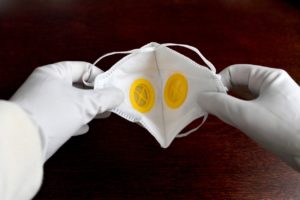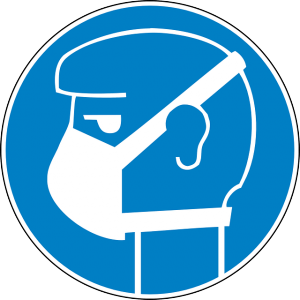Ian Kelsall, Technical Specialist, Respiratory Protection Equipment (RPE) at Dräger Safety UK shares his view on overlooked areas of PPE, including individual wearer characteristics and face shape which, if not considered, can have adverse effects on the level of safety for the wearer.

Ian Kelsall, Technical Specialist at Dräger.
Today’s workforce is becoming increasingly diverse, with representation across gender, age, ethnicities, and religions. But despite this indisputable fact, Personal Protective Equipment (PPE) has remained largely unchanged in its design, often having been created for the average size white male, with very little accommodation for those who fall outside of these specifications.
One particular area of concern is the fit on respiratory protective equipment (RPE), in particular items that need a tight seal to the face, such as Filtering Face Piece (FFP) disposable masks, which provide critical respiratory protection from dust and particles. Such protection is vital across a wide range of industries and applications, including healthcare, manufacturing, construction and pharmaceuticals.
Those specifying respiratory protection equipment for their workforce often focus on the first of the two key steps required in its selection, which is ‘Is it adequate for the hazard and does it reduce exposure to the level required?’
However, the second requirement ‘Is it suitable for the wearer, the task and the environment?’ can be more challenging as it includes the suitability for an individual.
Employers are legally required to carry out fit testing for all of their employees who wear tight-fitting respirators, and finding a mask, that will fit, and is suitable for every individual. This is where problems arise.
Standard designs do not accommodate variety of face shapes
An example of the significance of the problem is demonstrated by a study conducted in NHS hospitals in 2023 which involved 5604 healthcare workers. A total of 9592 observations were made regarding fit test outcomes on respiratory protective equipment (RPE).
 The study concluded that females and non-white ethnicities were less likely to have a successful respirator fitting, while male and white ethnicity healthcare workers were most likely to achieve RPE fit test success.
The study concluded that females and non-white ethnicities were less likely to have a successful respirator fitting, while male and white ethnicity healthcare workers were most likely to achieve RPE fit test success.
This is perhaps not wholly surprising and illustrates that a standard design FFP mask will not accommodate the wide variety of face shapes and facial features present in industry.
Fit is clearly an essential component to ensure safety across all workplace environments but when it comes to respiratory protection, safety of the workforce can also be affected by employees not complying with wearing the equipment, and fit is also relevant here, as poor fitting respiratory equipment will be uncomfortable, or the mask simply ‘won’t feel right’ and therefore workers may wear the RPE incorrectly, or not at all.
When it comes to the fit of a mask, design plays a crucial role and is key to creating RPE that meets the changing requirements of today’s diverse workforce.
By understanding the needs of different workers, designers can create equipment that is both functional and comfortable. It is therefore important to consider factors such as fit, weight, and breathability of the mask, as well as the specific hazards that workers may face.
Considerations for the individual wearer
Other questions also affect whether a particular mask is suitable for the individual wearer. Do they have deep cuts, wrinkles, moles, or warts, or struggle with a tight fit for medical reasons? Does the wearer have facial hair, or stubble?
A wearer being clean shaven is essential to mask fit. This has always – and increasingly so in recent years as beards have become more popular again – meant that specifying suitable RPE for these wearers has been a problem. For these groups a mask is often not an option, so a different approach is needed.
In these scenarios, a power air purifying respirator (PAPR) would be a more appropriate solution. When fitted using a loose-fitting headpiece which covers the entire head, it negates the need for a tight fit and a face seal, allowing a wider proportion of workers to remain safe in the workplace. Therefore, many employers specifying RPE for a diverse workforce are turning to PAPR as a solution.
Case study
 As a manufacturer of RPE, Dräger experience across a broad portfolio of products for respiratory protection against dust, vapour, gas or aerosols, from FFP masks to Powered Air Purifying Respiratory Protection (PAPR).
As a manufacturer of RPE, Dräger experience across a broad portfolio of products for respiratory protection against dust, vapour, gas or aerosols, from FFP masks to Powered Air Purifying Respiratory Protection (PAPR).
Customer research was conducted with 36 customers across seven countries, benchmarking 16 products through 50 participants, looking at a wide range of face shapes and sizes. The faces of the participants were mapped using a grid system, which looked at the face width, length depth and mouth width.
Analysis of this information found that by employing innovative design approaches which focus on a pioneering three-fold design, greater flexibility in both height and width is facilitated. This, combined with easy-adjustment capabilities, ensures that the mask stays in place, which is particularly important in allowing the wearer to speak while maintaining the all-important protective seal for a perfect fit.
At the same time, the use of flexible nose clip and soft wide nose pad enables the mask to be effectively positioned and securely sealed in the nose area. As a result of this innovative new approach to the design, it was found that developing masks in two sizes, would accommodate the majority of different face shapes and sizes and extensive testing by Dräger showed a 96% pass rate in face fit test procedures.
Conclusion
In conclusion, designing and manufacturing PPE to meet the needs of today’s diverse workforce is essential for ensuring the safety and wellbeing of workers in the UK. Key to this is manufacturers’ recognition of the diverse needs of different individuals and leveraging new technologies and materials, so that designers can create equipment that is functional, comfortable and suitable for the needs of as many individuals as possible.
This inclusivity will keep people safe in the workplace; both from the hazards present today and from those which may be experienced in the future.
Protection for Everyone - SHP's Inclusive PPE Campaign
SHP is running a campaign to bring awareness around the issues of ill-fitting PPE and lobby Government to bring about change.
We'll work alongside a range of stakeholders including suppliers and distributors, industry bodies, and, importantly, those who have experienced ill-fitting PPE.
Please contact us ([email protected]) to get involved, share your stories and support a campaign that affects everyone!


 The study concluded that females and non-white ethnicities were less likely to have a successful respirator fitting, while male and white ethnicity healthcare workers were most likely to achieve RPE fit test success.
The study concluded that females and non-white ethnicities were less likely to have a successful respirator fitting, while male and white ethnicity healthcare workers were most likely to achieve RPE fit test success. As a manufacturer of RPE, Dräger experience across a broad portfolio of products for respiratory protection against dust, vapour, gas or aerosols, from FFP masks to Powered Air Purifying Respiratory Protection (PAPR).
As a manufacturer of RPE, Dräger experience across a broad portfolio of products for respiratory protection against dust, vapour, gas or aerosols, from FFP masks to Powered Air Purifying Respiratory Protection (PAPR).